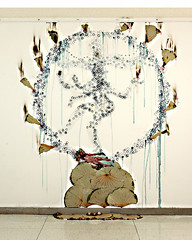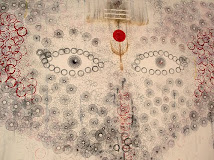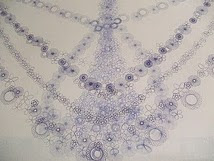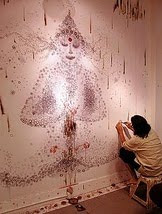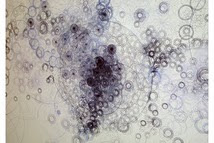Friday, July 15, 2011
Sunday, July 10, 2011
Drawn in a Day
Drawn in a Day
Friday, July 15 from 1 - 9:30 p.m
Guest Curator: Robert Raczka
SPACE
Guest Curator: Robert Raczka
SPACE
July 15 - September 4, 2011
812 Liberty Avenue
Pittsburgh, PA 15222
phone 412.325.7723
fax 412.325.7725
www.spacepittsburgh.org
12 artists or collaborative teams will each create a large drawing directly on the walls of the gallery. The gallery will be open to the public to observe the art-making process on Friday, July 15 from 1 - 9:30 p.m. The drawing process will overlap with the gallery crawl, which is scheduled for 5:30-9:30 p.m., and following the opening reception,
812 Liberty Avenue
Pittsburgh, PA 15222
phone 412.325.7723
fax 412.325.7725
www.spacepittsburgh.org
12 artists or collaborative teams will each create a large drawing directly on the walls of the gallery. The gallery will be open to the public to observe the art-making process on Friday, July 15 from 1 - 9:30 p.m. The drawing process will overlap with the gallery crawl, which is scheduled for 5:30-9:30 p.m., and following the opening reception,
DJ Pete Spynda will be playing until midnight.
Wednesday, August 18, 2010
Ganesh (2010)
Ganesh
Spirograph, ink, graphite, latex paint, gouache, watercolor, kum-kum powder, tumeric, incense, fire and found objects.
Curated by Adam Welch February 5, 2010 - March 28, 2010
Monday, March 8, 2010
Ganesh (2010)
Ganesh
Spirograph, ink, graphite, latex paint, gouache, watercolor, kum-kum powder, tumeric, incense, fire and found objects.
2010 @ The Pittsburgh Center For the Arts from the exhibition Cluster.
Curated by Adam Welch February 5, 2010 - March 28, 2010

Curated by Adam Welch February 5, 2010 - March 28, 2010

Ganesh is the fifth installment in my continuing series (since 2001) of site specific wall drawings created utilizing a Spirograph, the 1960's drawing toy for children.
Ganesh (or Ganesha), is the beloved Hindu God with the head of an elephant (representing the Atman or soul), and a body in human form. Ganesh is known as The Lord of Beginnings, The Lord of Success and The Remover of Obstacles. He is one of the five primary Hindu deities, along with Brahma, Vishnu, Shiva and Durga. The first action in almost all Hindu pujas (devotional rituals) is to honor Ganesh.
I first started working with the Spirograph in 2001, and quickly discovered it's potential as a tool for meditative, ritualistic drawing practices. Around that time I also began a music project to facilitate my meditation and yoga practice, based on the concept(s) of mantra. I called it Loop Yoga. Loop Yoga utilizes sampled music in the creation of repetitious sound currents with the intention of deeply connecting to the divinity encased within a sound structure. Together I have dubbed these (drawing and sound) investigations The Loop Yoga Project. The ephemeral, mutable and repetitive elements of this work points towards the cyclical nature of life. I attempt to illustrate the idea that life is ultimately a spiritual process through which one can discover a deeper union with (a) timeless reality. View the complete set of images here on my Flickr site.
Tuesday, January 19, 2010
Sunday, January 17, 2010
drawing | becoming
Becoming
from The Buddha Project
Wall drawing at Gallery U, Cleveland 2004
Ink, spirograph, fire, wax, incense, rocks, orange, honey
from The Buddha Project
Wall drawing at Gallery U, Cleveland 2004
Ink, spirograph, fire, wax, incense, rocks, orange, honey
Becoming (2004)
Becoming
from The Buddha Project
Wall drawing at Gallery U, Cleveland
2004
Ink, spirograph, fire, wax, incense, rocks, orange, honey
Becoming illustrates the idea of life as a cyclical process.
A site specific drawing made directly on the walls of the
gallery. The drawing itself (made with the use of a spirograph, the 1960's art making device for children) contains thousands of various circles representing Buddha.
Buddha nature / Buddha mind become recognized as both form and formlessness . The first phase of the drawing was completed in four successive days, and was continued for three more days of drawing spread over over a period of 3 months.
In this particular piece, the temporary nature of the work relates to Buddhist concepts of impermanence and non-attachment, referencing
the sand mandalas created by Tibetan Buddhist monks which are meticulously created over a short period of time and then swept up and dispersed into a flowing river or stream.
At the completion of the show the Buddha was washed away.
Copyright © 2004 David Pohl
HOP | House of Pingting Archives
from The Buddha Project
Wall drawing at Gallery U, Cleveland
2004
Ink, spirograph, fire, wax, incense, rocks, orange, honey
Becoming illustrates the idea of life as a cyclical process.
A site specific drawing made directly on the walls of the
gallery. The drawing itself (made with the use of a spirograph, the 1960's art making device for children) contains thousands of various circles representing Buddha.
Buddha nature / Buddha mind become recognized as both form and formlessness . The first phase of the drawing was completed in four successive days, and was continued for three more days of drawing spread over over a period of 3 months.
In this particular piece, the temporary nature of the work relates to Buddhist concepts of impermanence and non-attachment, referencing
the sand mandalas created by Tibetan Buddhist monks which are meticulously created over a short period of time and then swept up and dispersed into a flowing river or stream.
At the completion of the show the Buddha was washed away.
Copyright © 2004 David Pohl
HOP | House of Pingting Archives
Nataraja (2003)
A site specific drawing made directly on the walls of the gallery.
The drawing itself (made with the use of a spirograph, the 1960's
art making device for children) contains thousands of various size
small circles representing "The Cosmic Dancer", an ancient image
of Shiva, Lord of the Dance, dating back to prehistoric times
in India. The drawing was completed in three days.
Copyright © 2003 David Pohl
HOP | House of Pingting Archives
Nataraja
By Anu Kumar
Nataraja, "The Cosmic Dancer" is an ancient image of the divine dating back to prehistoric times in India. The earliest figurines are cast in stone and found amidst the ruins of the Indus Valley civilization (circa 4000-2800 C.E.) Later representations are cast in either bronze or iron and to be found in southern india from the time of the Chola Dynasty (800-1100 A.D.) The most famous of these is installed in the Siva temple at Chidambaram in Tamil Nadu where for centuries it has inspired the imagination and fervent devotion of pilgrims from all over India.
The image is deceptively simple at first glance. It reveals a sure-footed dancer-figure firmly holding down a crouched demon while the other is half-raised in a balancing pose. Four arms reach out expressively - the one on the left holds up a lighted torch from which issue burning flames that form a majestic aureole or a halo of fire around the figure, at once illuminating and encircling it. The right arm holds up a drum, the flying tassels of which indicate a rhythmic song in progress. The lower left hand is held up with palm out in a symbolic gesture, or "mudra", indicating and exhorting fearlessness. The lower right hand reaches gracefully across a lithe torso pointing down towards the delicate foot that is raised in movement. Here rest and salvation are assured to those seeking sincerely. The figure is androgynous with a dangling earring on the left side. Adorned with snakes as armlets, it holds the crescent moon like a jewel-clasp in the hair which is other-wise aflight in all directions in the frenzied ecstasy of dance.
Seen in the mystic imagination of poets from long ago, The Nataraja is a profound vision of the Absolute. This god is by no means aloof or hidden apart from creation in some transfixed realm. Rather He is supremely alive to a present moment in time that is charged with an extraordinary power and bliss. He is utterly joyful and unconstrained. The mystery of such joy lies in a paradox: to be alive is to die each moment and create anew. The Cosmic Dancer has an unstinting capacity to endure his own death and to leap forth into an unknown place where He will be emptied of every familar position or posession, claim or identity - indeed, of life itself. Through such a complete reversal and sacrafice, then, the Dancer attains a new life in an open ground that is now illuminated by the fires of self-knowledge and a triumphant self-awareness. This is the prize, the deepest mystery of His joy. The Nataraja is in complete union- is unity itself as living truth of action.
The sense of unity is expressed through a fine sensitivity to balance by the Cosmic Dancer. Rising above fear and ignorance, this deity knows that movement is an expansion from the limited into the unlimited, of matter into spirit, because He understands balance. Opposites abide in Him rather than exsisiting without: death and creation, lightness and dark, joy and pain, are but complementary poles to be conjoined through harmony and poise. The central axis of the Dancer's body is like a spinal column that knows an exquisite connection to all space and holds it together. Then the entire panorama of the world becomes a play or "lila"- a game, a dance, a spontaneous outflow of energy. The sacred is everywhere and in every step.
The drawing itself (made with the use of a spirograph, the 1960's
art making device for children) contains thousands of various size
small circles representing "The Cosmic Dancer", an ancient image
of Shiva, Lord of the Dance, dating back to prehistoric times
in India. The drawing was completed in three days.
Copyright © 2003 David Pohl
HOP | House of Pingting Archives
Nataraja
By Anu Kumar
Nataraja, "The Cosmic Dancer" is an ancient image of the divine dating back to prehistoric times in India. The earliest figurines are cast in stone and found amidst the ruins of the Indus Valley civilization (circa 4000-2800 C.E.) Later representations are cast in either bronze or iron and to be found in southern india from the time of the Chola Dynasty (800-1100 A.D.) The most famous of these is installed in the Siva temple at Chidambaram in Tamil Nadu where for centuries it has inspired the imagination and fervent devotion of pilgrims from all over India.
The image is deceptively simple at first glance. It reveals a sure-footed dancer-figure firmly holding down a crouched demon while the other is half-raised in a balancing pose. Four arms reach out expressively - the one on the left holds up a lighted torch from which issue burning flames that form a majestic aureole or a halo of fire around the figure, at once illuminating and encircling it. The right arm holds up a drum, the flying tassels of which indicate a rhythmic song in progress. The lower left hand is held up with palm out in a symbolic gesture, or "mudra", indicating and exhorting fearlessness. The lower right hand reaches gracefully across a lithe torso pointing down towards the delicate foot that is raised in movement. Here rest and salvation are assured to those seeking sincerely. The figure is androgynous with a dangling earring on the left side. Adorned with snakes as armlets, it holds the crescent moon like a jewel-clasp in the hair which is other-wise aflight in all directions in the frenzied ecstasy of dance.
Seen in the mystic imagination of poets from long ago, The Nataraja is a profound vision of the Absolute. This god is by no means aloof or hidden apart from creation in some transfixed realm. Rather He is supremely alive to a present moment in time that is charged with an extraordinary power and bliss. He is utterly joyful and unconstrained. The mystery of such joy lies in a paradox: to be alive is to die each moment and create anew. The Cosmic Dancer has an unstinting capacity to endure his own death and to leap forth into an unknown place where He will be emptied of every familar position or posession, claim or identity - indeed, of life itself. Through such a complete reversal and sacrafice, then, the Dancer attains a new life in an open ground that is now illuminated by the fires of self-knowledge and a triumphant self-awareness. This is the prize, the deepest mystery of His joy. The Nataraja is in complete union- is unity itself as living truth of action.
The sense of unity is expressed through a fine sensitivity to balance by the Cosmic Dancer. Rising above fear and ignorance, this deity knows that movement is an expansion from the limited into the unlimited, of matter into spirit, because He understands balance. Opposites abide in Him rather than exsisiting without: death and creation, lightness and dark, joy and pain, are but complementary poles to be conjoined through harmony and poise. The central axis of the Dancer's body is like a spinal column that knows an exquisite connection to all space and holds it together. Then the entire panorama of the world becomes a play or "lila"- a game, a dance, a spontaneous outflow of energy. The sacred is everywhere and in every step.
The Dance
At the still point of the turning world, there the dance is.
Without the point, the still point, there would be no dance,
and there is only the dance.
~ T. S. Eliot
hypotrochoids and epitrochoids
Hypotrochoid describes a family of curves. Hypotrochoid and epitrochoid are roulette of two circles. If one circle is inside another, the curve traced are called hypotrochoids. Otherwise (one rolls outside another), the curves are called epitrochoids. If the tracing point is on the (circumference) rolling circle, the curves are called hypocycloid or epicycloids. Hypotrochoids are also known as SpiroGraph — a tradmark of a toy that trace limited cases of hypotrochoids.
[Source] A Visual Dictionary of Special Plane Curves
[Source] A Visual Dictionary of Special Plane Curves
Wednesday, January 13, 2010
Spirograph
Spirograph is a geometric drawing toy that produces mathematical curves of the variety technically known as hypotrochoids and epitrochoids. The term has also been used to describe a variety of software applications that display similar curves, and applied to the class of curves that can be produced with the drawing equipment (so in this sense it may be regarded as a synonym of hypotrochoid). The name is a registered trademark of Hasbro, Inc.
The Spirograph was invented by British engineer Denys Fisher who exhibited it in 1965 at the Nuremberg International Toy Fair. It was subsequently produced by his company. Distribution rights were acquired by Kenner, Inc., which introduced it to the United States' market in 1966.
[Source] Wikipedia
The Spirograph was invented by British engineer Denys Fisher who exhibited it in 1965 at the Nuremberg International Toy Fair. It was subsequently produced by his company. Distribution rights were acquired by Kenner, Inc., which introduced it to the United States' market in 1966.
[Source] Wikipedia
Becoming
Becoming (2004)
Ink, spirograph, fire, wax, incense, rocks, orange, honey
The Buddha Project
Wall drawing at Gallery U, Cleveland
Co-Curated by Jeanne Grosetti and Robert Thurmer (Cleveland State University)
A site specific drawing made directly on the walls of the gallery. The drawing itself (made with the use of a spirograph, the 1960's art making device for children) contains thousands of various small circles representing the Buddha as a formless form. The first phase of the drawing was completed in four days, and was continued over a period of 3 months.
In this particular piece, the temporary nature of the work relates to Buddhist concepts of impermanence and non-attachment, referencing the sand mandalas created by Tibetan Buddhist monks which are meticulously created over a short period of time and then swept up and dispersed into a flowing river or stream.
At the completion of the show the Buddha drawing was washed away.
Copyright © 2004 David Pohl | HOP | House of Pingting Archives
Subscribe to:
Posts (Atom)












